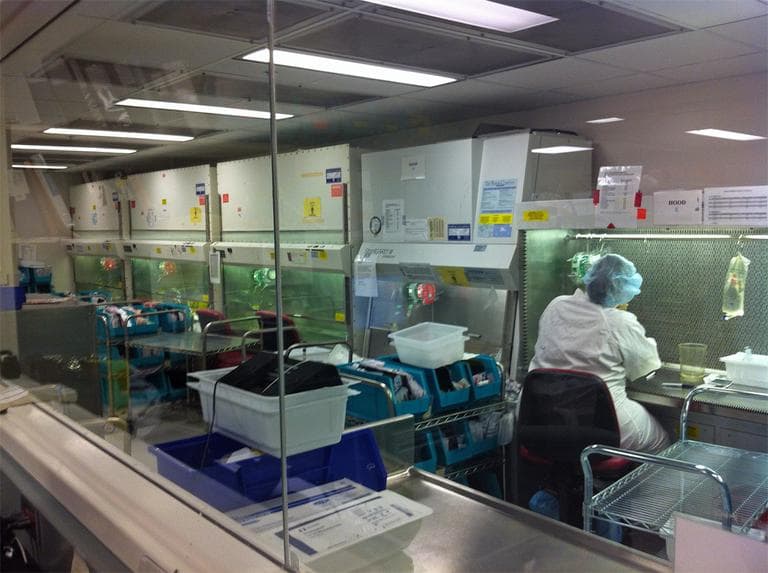Advertisement
Hospital Pharmacies Step Up Compounding Efforts In Wake Of Meningitis Outbreak
ResumePhysicians and hospitals are scrambling for the specialty compounds produced by the New England Compounding Center in Framingham and a related company, Ameridose. Both companies closed following the national meningitis outbreak caused by contaminated steroids made by NECC that killed 36 people and sickened 510.
Some hospitals in Massachusetts are responding in ways that could be better for patients.
MGH Pharmacy Goes 24/7

Patients at Massachusetts General Hospital take some 400,000 doses of medication every month — 4.8 million a year. And until two months ago, close to a million of them were compounded by third-party vendors, such as NECC and, even more, Ameridose. Now, most of that work has been brought in house to MGH's central pharmacy.
It's a clinical beehive where technicians in varying surgical outfits fill IV bags and sort syringes. Behind air-locked doors, more workers sit under high-tech bays — or "hoods" — compounding sterile medications.
Just outside this "clean room," lead technician Meghan Federico sorts test tubes.
"It's what we put our samples in, specimen samples, to test for sterility," Federico said.
No doubt this was a busy place before Ameridose was closed. But now, this lab is really humming.
"We've increased our hours. We have three hoods that are full on all three shifts, that we didn't have before," Federico said. "We were Monday through Friday 7:30 to 4:00 operation, and now we're 24/7."
Before the meningitis outbreak, MGH was already contending with the national shortage of some drugs. Now the hospital has amped up its drug management and compounding effort. And new discussions among physicians and pharmacists may be leading to changed — and better — prescribing practices.
Streamlining Practices
Dr. Padma Gulur, director of inpatient pain services at MGH, cites the example of a pain killer called hydromorphone — a quite effective, and quite addictive, drug.
"That makes it less than an ideal first-line prescribing agent, an opioid choice in an acute setting," Gulur explained, "because we are introducing patients to high-potency medications when there are alternatives that they should have been exposed to earlier."
Morphine, for one. After state regulators shut down the Ameridose pipeline, the hospital's chief pharmacist, Margaret Clapp, faced some choices. Even with added staff, she needed to consolidate the number of medications they'd secure and compound each day. She suggested to Dr. Gulur that morphine be dropped from the list.
"And I can't tell you what she called me when I suggested that because what she really wanted to do was, what she said was, 'Wait a minute, our goal is to be using morphine first. What do you mean?' " Clapp said. "And having the numbers in front of us on a daily basis in trying to manage patients pointed out to us that we could do better."
"This put it in concrete numbers in front of us, and it was startling," Gulur added. "And it brought it home that, here is an opportunity for clinical process improvement which has wide impacts."
So both agree morphine is a better choice, and it's now prescribed more often than hydromorphone at MGH. And Clapp, the chief pharmacist at MGH, is more closely monitoring her entire inventory of all compounded medications, including pain killers, antibiotics and anesthesia. In some cases, she's whittled down the menu. In others she passed work onto other departments — qualified anesthesiologists, for instance, are now mixing some of their needed drugs themselves, qualified nurses are taking up slack too.
MGH isn't the only hospital in Massachusetts taking these steps, says Dr. Gary Kerr, chief pharmacist at Baystate Medical Center in Springfield and president of the Massachusetts Society of Health-System Pharmacists.
"We are having very difficult, thoughtful conversations about each drug, each strength. You know, do you need to use it in this particular situation?" Kerr said. "It's forcing some good dialogue between the front-line providers and the pharmacists."
Back at MGH's pharmacy department, just such a dialogue breaks out between Dr. Gulur and pharmacist Paul Arpino. Sitting in a foyer, they debate the best way to administer local anesthetic lidocaine:
Arpino: But I have to look at the concentration for it.
Gulur: But it's not going to be statistically significant anyways, so.
Arpino: So again it's one of those things, you can check dig levels, you can check 10 individuals.
Gulur: You're telling me I'm looking for a needle in a haystack.
Arpino: A little bit, a little bit, but that's OK, that's what we do.
Hospitals and state regulators continue to seek ways to cover the supply gap left by the closure of NECC and Ameridose — and to cover the added costs. The state may allow Ameridose to reopen next year, but pharmacists aren't counting on it. MGH's parent organization, Partners HealthCare, is mulling the idea of creating its own compounding pharmacy that would serve all the hospitals in its system.
This article was originally published on November 28, 2012.
This program aired on November 28, 2012.